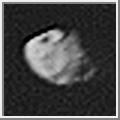 Pandora
Pandora Pandora
PandoraSaturn X - 1980S26

Pandora [pan-DOR-uh] is the fourth of Saturn's known satellites. It was discovered from photographs taken by Voyager during its encounter with Saturn by S. Collins and others. Pandora is the outer shepherd satellite for Saturn's F-ring. It has a diameter of about 114 by 84 by 62 kilometers (71 by 52 by 38 miles) and appears to be very heavily cratered. The two largest craters are about 30 kilometers (19 miles) in diameter. No linear valleys or ridges are visible. Very limited data is available to analyze Pandora.

Discovered by ........................... S. Collins & others Date of discovery ...................................... 1980 Mass (kg) .......................................... 2.2e+17* Mass (Earth = 1) ................................. 3.6814e-08 Radius (km) ........................................ 57x42x31 Radius (Earth = 1) ............................... 8.9370e-03 Mean density (gm/cm^3) ................................. 0.7* Mean distance from Saturn (km) ...................... 141,700 Rotational period (days) .................................. ? Orbital period (days) ................................ 0.6285 Mean orbital velocity (km/sec) ........................ 16.40 Orbital eccentricity .................................. 0.004 Orbital inclination ..................................... 0.0° Escape velocity (km/sec) ............................. 0.0227 Visual geometric albedo ................................. 0.9 Magnitude (Vo) ......................................... 16.5

 Pandora
(GIF, 9K)
Pandora
(GIF, 9K)
This image of Pandora was acquired by the Voyager 2 spacecraft on
August 25, 1981.
(Credit: Calvin J. Hamilton)
 Shaded Map of Pandora
(GIF, 64K;
caption)
Shaded Map of Pandora
(GIF, 64K;
caption)
This is a shaded relief map of Pandora, the outer F Ring
shepherd
satellite of Saturn. As with all maps, it is the cartographer's
interpretation and not all features are necessarily certain given the
limited data available.
This interpretation stretches the data as far as
is feasible. The leading side faces forwards in the orbit of Pandora.
The trailing side faces backwards along the orbit.
Longitude 0 is at the righthand end of the leading side, and faces Saturn.
As with all conformal (true shape) projections, the scale in these maps
varies, increasing from the center to the outer edge.
(Courtesy Phil Stooke).
 Prometheus and Pandora
(GIF, 73K)
Prometheus and Pandora
(GIF, 73K)
This image shows Prometheus and Pandora
next to Saturn's F-ring.
(Courtesy NASA/JPL)


